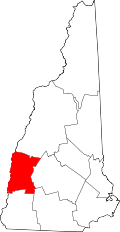Trinity Church | |
 | |
| Location | 833 Route 12A Cornish, New Hampshire |
|---|---|
| Coordinates | 43°28′00″N72°23′06″W / 43.46667°N 72.38500°W |
| Area | 1 acre (0.40 ha) |
| Built | 1803-1808 |
| Architect | Philip Tabor |
| NRHP reference No. | 78000419 [1] |
| Added to NRHP | July 31, 1978 |
Trinity Church is an historic church located at 833 Route 12A in Cornish, New Hampshire, in the United States. It began in 1793 as the Episcopal Society and became Trinity Episcopal Church in 1795. Instrumental in its establishment was Philander Chase, son of one of the three founders of Cornish and then a student at Dartmouth College. Chase later became the first bishop of the Episcopal Diocese of Ohio, the first bishop of the Episcopal Diocese of Illinois, and Presiding Bishop of the Episcopal Church in the United States of America. Construction of the church began in 1803 and was finished in 1808. On February 1, 1980, it was added to the National Register of Historic Places. Its historic graveyard is known as Trinity Cemetery. After decades of being vacant, the church was reopened in 2004 as Trinity Anglican Church.


